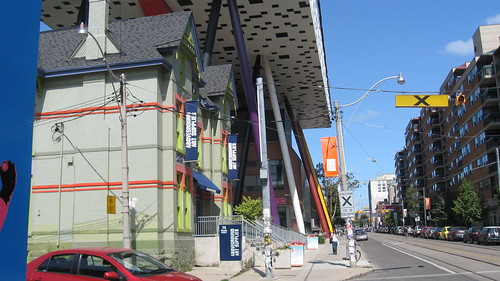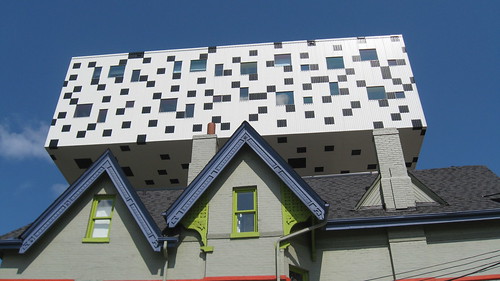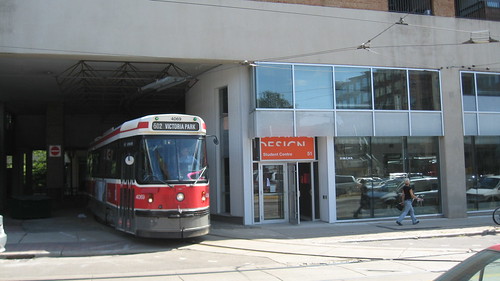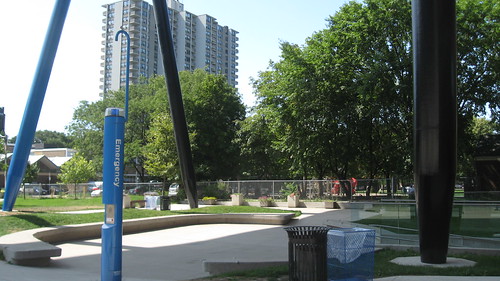
EDITOR’S NOTE: Spacing asked our summer intern Matthew Hague to visit all of Toronto’s post-secondary institutions and examine the built form of each campus. Every day over the next week, we will feature a campus profile.
– – – – – – – – – – – – –
Having spent a large part of the summer working near Queen and Beverley streets, I really appreciate OCAD‘s small but colourful campus. Right beside Grange Park, the large overhang of architect Will Alsop’s Sharp Centre for Design is a really great place to stay dry when it’s raining (and after a while the crayon-coloured stilts really grow on you), and the Above Ground Art Supplies store is a great place to buy all things artsy (Above Ground has a large selection and offers student discounts, for people attending OCAD or otherwise). The school is known for pushing the limits in contemporary art and design, and is built on a deep tradition of producing artistic talent. OCAD was the first school in Canada dedicated to educating young commercial and fine artists, and was founded in 1876 in a space on King Street West by the Ontario Society of Artists. Following several name changes the school was incorporated as the Ontario College of Art in 1912, then renamed again as OCAD in 1996. Since its foundation the school has attracted both talented students and faculty, ranging diversely from J.E.H Macdonald (a former principal) to Floria Sigismondi (a former student).

The school’s first dedicated building still sits on Grange Park just south of the Sharp Centre. Opened in 1921 by the school’s principal, George A. Reid, who also designed the building, the Grange Wing was integrated into the main building in a 1957 expansion. That Reid’s Grange wing is still a part of the campus is interesting, particularly in light of the school’s needs to expand — I like the fact that you can look from the oldest to the newest buildings to see how the school’s vision has evolved over time (from something that looks quite traditional to a school clearly willing to take chances). The contrasts of old and new are further emphasized when looking at 100 McCaul, OCAD’s Main Building (that the Sharp Centre literally hovers over) that designed in the modernist style predominant in the 50’s.


OCAD also has seven other spaces dispersed throughout the vicinity, including the Student Gallery on Dundas Street and the Student Centre further south on McCaul. The Student Gallery, though small, has great curated exhibitions featuring student works. It was closed for the summer when I was walking around campus taking pictures, but I have been in during other times of the year and found the works interesting. The Student Centre, designed by Baird Sampson Neuert, is the school’s first dedicated student centre, and has a contemporary street front with the anomoly of having a working streetcar line running through it. The Student Centre houses the Student Union, as well as financial aid, career advisory, and other student services. One of the more hidden spaces on campus is the Annex Building, accessed through the Village by the Grange commercial centre across McCaul Street from the Main Building. Hidden away from the bustling food court and shops of the commercial area is classroom and studio space for the first-year program, OCAD’s Dorothy H. Hoover Library, and other facilities.

In 2004 the school officially opened its $ 42.5-million campus redevelopment project, including the now famous Sharp Centre for Design. As I mentioned above, the Sharp Centre for Design is interesting because it literally hovers above the Main Building at 100 McCaul, supported by long, colourful steel legs, but this design allows for the small parkette (where an extension to the school might otherwise have gone) to remain open — making that park a great place to be during a rain storm, with the Sharp Centre acting like a giant umbrella. Though criticized by some for its offbeat aesthetics, the Sharp Centre is technically intruiging — each of the crayon-like legs were originally designed as tubes for a pipeline, are made of 1″ thick steel, and weigh 18,000 pounds apiece. The development project was more than the Sharp Centre however, also including renovations to many of the school’s other spaces such as the new Student Gallery (mentioned above) on Dundas Street. In addition to the redevelopment project, OCAD has furthered expanded its campus by acquiring 205 Richmond Street West at Duncan, and will likely use the seven-storey space for administration and graduate student offices.

One thing that the campus lacks, however is a residence — meaning that the approximately 3,400 students at the school either live at home or have to find their own housing. Apparently, for a fee, students can use U of T’s student housing services to help look for a place, and there are student co-ops near the school where students can live. Notwithstanding the lack of residence space, the area around OCAD is still great for art and design students, with many practitioners having studio space nearby (in particular architects and designers), not to mention the school’s legendary neighbour, the Art Gallery of Ontario (sitting at northern edge of Grange Park) — which when its Frank Gehry-designed renovation is completed, will likely be an important reference point for not only art but also architectural design within the city.

4 comments
In your tour you seem to have somehow managed to take pictures of all these campuses with no students. How did you manage. The relative absence of students disturbs me for some reason. Are you really a magician?
rmp, he does mention this was done in the summer – if it was late August between terms, it’s very easy to find near-empty campus spaces.
I would have liked a picture or two of the 1957 building for comparison as well, but a good piece all the same.
Yes it was done in the summer, not in the recent weeks when students began to invade their campuses once again
Wow, that’s amaing! I love the building!